|
Cast Performance bullet company has been making high quality, hard-cast
lead bullets in Riverton, Wyoming for several years. They use only the finest
materials to produce some of the best quality cast bullets available anywhere.
Their bullets are sold not only to shooters and hunters directly, but are loaded into some of the
best factory ammunition available, including premium ammo from Cor-Bon,
Federal, and Buffalo Bore.
Recently, I have been shooting some of the Cast Performance bullets in the
excellent LBT design. The two styles that I will concentrate on for purposes
of this article are the .44 caliber wide flat nose (WFN) and the .44 caliber
wide long nose (WLN). Both of these bullets are of gas check design and they weigh 300 grains
and 320 grains, respectively. The LBT design bullets are some of the best
available for hunting the largest of big game. They have a large, flat nose to achieve
maximum tissue disruption and wound channel damage. They are also the best design to get the heaviest bullet
for any given caliber. The profile of the bullet nose, ogive, and shank, allow for
an accurate bullet that can be depended upon to penetrate much deeper than a
conventional softpoint.
Cast Performance uses virgin lead alloy to achieve a consistent product.
Many commercial bullet casters use scrap or salvage lead to make their products. There is nothing wrong with
this approach to bullet making when the intended use is plinking or casual
target shooting, but don't confuse the two products. Scrap lead allows bullet
casters to make a serviceable product at a relatively cheap price. Cast Performance makes premium
bullets for serious hunters.
After casting, the bullets are gas checked and lubricated to allow
maximum velocity without leading the barrel. Leading can be a real problem
in most barrels at high velocity when using cast bullets of the wrong design
or alloy.
To further enhance performance, Cast Performance heat treats their bullets
to achieve hardness without becoming brittle. A bullet that is made too hard
from the wrong alloy will break apart on heavy bones and fail to penetrate
to the vitals of the animal, leaving a nasty surface wound and little else.
To check the ability of the Cast Performance 320 grain WLN to hold
together, I laid one on a concrete slab, nose up, and proceeded to smash it
with a 32 ounce framing hammer. The bullet in the accompanying photos
was hit, and hit hard, six times with the hammer to reach the degree of deformation shown. No pieces broke
off of the bullet, and it retained all of its 320 grain weight. Now, this isn't the
same as being slammed into the shoulder of a grizzly bear at 1400 feet per second, but not having a grizzly
handy, I have found that this hammer treatment will prove if a bullet is malleable enough, while still
maintaining the desired hardness to penetrate the largest animals on this continent. The Cast Performance
bullet passed the test.
I loaded up some .44 magnum cases with both the 300 grain WFN and the
320 grain WLN for velocity and accuracy testing in an "Old
Model" Ruger Super Blackhawk [Ed. Note: see Jeff's
article on the Old Model Super Blackhawk at Super Blackhawk
- Boge Quinn], and a Ruger Bisley. Both
sixguns have seven and one-half inch barrels, and differed mainly in the
design of their grip frame. I long ago discovered that when shooting heavy
loads in a single action handgun, the shape of the handle can mean the difference between exhilarating fun
and pain. The Bisley grip frame has earned a good reputation for being able to handle
heavy loads without being excessively punishing to the shooter. I have found in the past,
however, that a Super Blackhawk with a grip that fills in the area behind the
trigger guard is much better to my hand than anything that I have ever tried. On
the old model Super Blackhawk used here, I have fitted a set of Herrett's Shooting Star stocks
that I slimmed down to fit my hand better and left with a smooth finish. Nothing that I have
found handles heavy recoil better, and such was the case in this situation. With loads
exceeding 1400 feet per second using both the 300 and the 320 grain bullets,
shooting was a pleasure. Early in the tests, the bottom of one of the grip
panels split under recoil on the Bisley model. The ability of the Bisley grip to
comfortably handle the recoil was, while not as easy on the hand as the smooth modified Herretts on the
Super, still very good.
All through the tests, it was evident that the LBT design bullets, in both
styles and weights, were capable of very fine accuracy. The group shown here was
fired at 25 yards, and measured just over one and one-half inches. Later
load development proved that the bullets were capable of even better accuracy. As velocity increased, the
loads showed better consistency and lower mean average deviation.
The powder used throughout the test was Hodgdon's Lil'
Gun, and is quickly
becoming my favorite powder for the heaviest bullets in magnum sixgun
cartridges [Ed. Note: see Jeff's article on Lil' Gun at Hodgdon Lil' Gun Powder
- Boge Quinn]. The loads upon which I
settled pushed the 320 grain WLN bullet to 1375 fps and the 300 WFN to 1430. These loads were safe in my
Rugers, but showed excessive case head expansion in my Winchester 94 Trapper carbine.
Both of these bullets from Cast Performance proved capable of fine
accuracy and high velocity without leaving any lead in the barrel of either
of the test guns.
For the handgun hunter who needs maximum performance and accuracy,
these bullets from Cast Performance can't be beat. They offer these heat-treated LBT series bullets for
handgunners in every caliber from .357 to .500 and weights from 160 grain to 440, depending on caliber.
They also offer an extensive line of hard cast rifle bullets.
For hunters and shooters who don't load their own ammo, try Buffalo Bore
Ammunition at www.buffalobore.com
for premium ammunition for your handgun or rifle, or look for Federal's Cast-Core line of ammunition.
For those who prefer to load your own, contact Cast Performance at
www.castperformance.com or call
307-857-2940 for the finest commercial cast bullets I've ever used. They're
tough, accurate, and won't lead your bore. I highly recommend them.
Jeff Quinn
NOTE: All load data posted on this
web site are for educational purposes only. Neither the author nor
GunBlast.com assume any responsibility for the use or misuse of this data.
The data indicated were arrived at using specialized equipment under
conditions not necessarily comparable to those encountered by the
potential user of this data. Always use data from respected loading
manuals and begin working up loads at least 10% below the loads indicated
in the source manual.
  
Got something to say about this article? Want to agree (or
disagree) with it? Click the following link to go to the GUNBlast Feedback Page.
All content © 2001 GunBlast.com. All rights
reserved. |
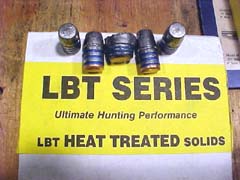
Cast Performance LBT Series gas-checked cast bullets. On the left is
the 300 grain WFN, on the right is the 320 grain WLN.
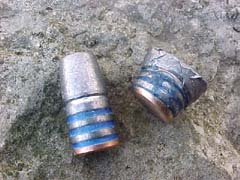
Cast Performance 320 grain WLN. Bullet on the right was smashed by
the author with a hammer as described in the article.
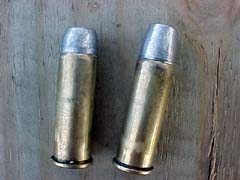
The author's test loads, both in .44 magnum. At left is the 300
grain WFN, at right is the 320 grain WLN.
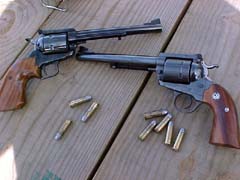
Test guns were a 7-1/2" Old Model Ruger Super Blackhawk fitted
with customized Herrett's "Shooting Star" stocks (left), and a
7-1/2" New Model Ruger Bisley.
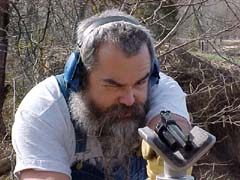
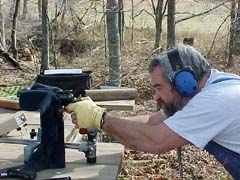
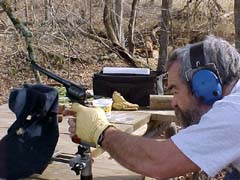
Author testing his loads for the Cast Performance bullets. Even at
over 1400 fps, the heavy cast bullets were a pleasure to shoot, thanks in
large part to the excellent recoil-handling qualities of the Ruger test
guns.
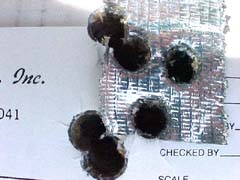
Six-shot group fired at 25 yards shows that Cast Performance bullets
are capable of very fine accuracy. Subsequent load development suggests
that even better accuracy is possible with these great bullets!
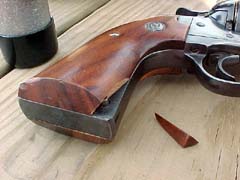
The Ruger Bisley's superb handling qualities made for a
comfortable and fun shooting session. The recoil of the 320 grain WLN
proved to be too much for one of the Bisley's grip panels, however, as the
right-hand panel split under recoil at the locator pin.
|
![]()